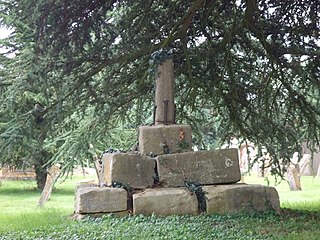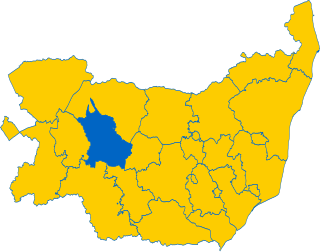
Babergh District is a local government district in Suffolk, England. In 2021 it had a population of 92,300. The district is primarily a rural area, containing just two towns, Sudbury and Hadleigh, which was the administrative centre until 2017 when the council moved to shared offices with neighbouring Mid Suffolk District Council in Ipswich, outside either district. The district is named after the medieval Babergh Hundred, which covered part of the area.

Ulleråker Hundred, or Ulleråkers härad, was a hundred of Uppland and Uppsala County in Sweden.

Edenham is a village and civil parish in the South Kesteven district of Lincolnshire, England. It is approximately 3 miles (5 km) north-west of Bourne, and on the A151 road. While the civil parish is called 'Edenham', the parish council is called Edenham, Grimsthorpe, Elsthorpe & Scottlethorpe Parish Council. The population of the civil parish at the 2011 census was 291.

Carlby is a small village and civil parish in the district of South Kesteven in Lincolnshire, England. The population of the civil parish at the 2011 census was 542.

Thedwastre was a hundred of the county of Suffolk, England covering an area of 40,362 acres (163.34 km2). It formed part of the Liberty of Saint Edmund, under the jurisdiction of the abbots of Bury St Edmunds.

Babergh was a hundred of Suffolk, consisting of 71,882 acres (290.90 km2). Its name survives in that of Babergh District, the local government district of southern Suffolk that includes the former hundred as well as those of Cosford and Samford.

Cosford was a hundred of Suffolk, consisting of 30,712 acres (124.29 km2).

Lackford was a hundred of Suffolk, consisting of 83,712 acres (338.77 km2).
Risbridge is a hundred of Suffolk, consisting of 58,468 acres (236.61 km2).
Stow was a hundred of Suffolk, consisting of 22,710 acres (91.9 km2).

Bosmere and Claydon was a hundred of Suffolk, consisting of 31,850 acres (128.9 km2).

Hoxne was a hundred of Suffolk, with an area of 55,648 acres (225.20 km2).

Loes was a hundred of Suffolk, with an area of 31,321 acres (126.75 km2).

Thredling was a hundred of Suffolk, and at just under 10,000 acres (40 km2) the smallest of Suffolk's 21 hundreds.

Carlford is a hundred of Suffolk, consisting of 25,461 acres (103.04 km2).

Colneis is a hundred of Suffolk, consisting of 16,712 acres (67.63 km2).
Plomesgate is a hundred of Suffolk, consisting of 41,579 acres (168.26 km2).
Mutford and Lothingland was a hundred of Suffolk, with an area of 33,368 acres (135.04 km2). Lowestoft Ness, the most easterly point of Great Britain fell within its bounds.

Wangford was a hundred of Suffolk, England, consisting of 34,679 acres (140.34 km2).

Wilford is a hundred of Suffolk, consisting of 31,500 acres (127 km2).

















